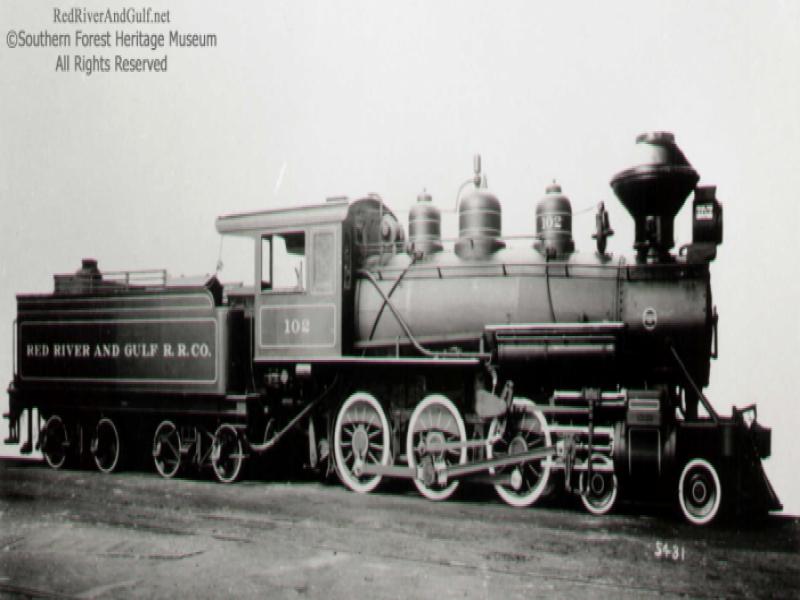The Red River & Gulf Railroad was born in 1905. Its parents were the Crowell & Spencer Lumber Company log tram and the stockholders of the Lumber Company of Long Leaf, Louisiana. Its "godfather" was George Gould, son of rail builder and rail baron, Jay Gould.
In 1895 Crowell & Spencer started construction of its first tramway from Long Leaf, building west and southwest to reach the first timber that the company purchased. By 1904, most of the timber along this line had been harvested and Crowell & Spencer looked toward timber that they had purchased since 1900. Most of this timber was located east of Long Leaf, both north and south of Spring Creek and Cocodrie Lake.
But for George Gould, C&SL would have simply extended the tram road into the new timber and that would have been it. However, Gould was trying to complete his father’s dream of a true transcontinental railroad under a single management, and the Crowell railroad connection at Long Leaf was part of the plan. Gould raised rates on everything that his railroads hauled to raise money for the construction of the final link in the plan, the Western Pacific Railroad. The Crowell response was to incorporate and build their own common carrier railroad, the Red River & Gulf (RR&G) , to connect Long Leaf with the other railroads that ran south and east from Alexandria. Reaching a junction with the Texas & Pacific at Lecompte, the railroad never constructed further east.
In order to efficiently log the amount of timber that Crowell & Spencer had acquired, a second company, the Meridian Lumber Company, was incorporated and a second sawmill and town were built at Meridian, Louisiana. The RR&G extended freight service to Meridian over the Crowell & Spencer and Meridian Lumber tramways by the end of 1913.
During 1914, the Louisiana Sawmill Co. began construction of a large sawmill on the southeast side of Glenmora at Bolton, 3 miles south of Long Leaf and 2 miles from Louisiana Junction
After completion of the Western Pacific Railroad drove the entire Gould Empire into bankruptcy, several Louisiana logging companies were able to purchase their timber holdings here, and the Red River & Gulf line was once again expanded.
The 1920’s were truly the glory days of the RR&G. In addition to the passenger train, separate mixed trains operated 6 days a week to Lecompte, Kurthwood and Meridian (eastbound only to Bolton). Extra freights operated almost daily as well. Unfortunately by the middle of the decade the boom days were over. Service on the Meridian Line was terminated after the Meridian Mill burned in May, 1928 and Meridian Lumber bought out Alexandria Lumber and transferred its operations to Alco. 1929 saw the end of the Kurthwood mill as a pine mill and the abandonment of much of the town of Kurthwood as well. Although the mill was re-opened in 1930 as a hardwood mill, it never shipped the carload volume that it had before 1929.
The great depression brought even more hardship to the RR&G and operations dwindled. However,war preparations caused naval construction to increase and Crowell long leaf pine timber was an essential part of that effort. Long Leaf pine will not rot in salt water due to its high density and high sap content and so was the preferred material to construct slipways to build large ships in the Navy yards and shipyards along the east and gulf coasts, so the mills and trains began to run daily.
After the Louisiana Maneuvers of 1940, the Army presence in western Louisiana was manifested in 2 airfields and 4 major training camps. The Army negotiated to take a large portion of the railroad network, but they eventually built their own railway between the Camps. The Navy continued to have a high demand for timber, not only for shipyards, but now as well for the thousands of landing craft that would be built at the Higgins Boat company in New Orleans. During the war, over 20,000 Higgins boats would be built and Crowell timber would be used in at least half of them.
By the end of the war, the demand caused Crowell Long Leaf Lumber to completely cut over the remainder of its acreage in Hutton-Alco and hardwoods that fed the Kurthwood mill. After the war, only the fact that the Rock Island at Lecompte actively sought the Crowell interchange kept the railroad alive. Officially, trains continued to operate the three day per week schedule, but in truth, they only operated when there were cars destined to and from the Rock Island. Crowell engine #300 operated for the last time in December, 1946, leaving only RR&G #106 and Crowell #400 active on the railroad.
Finally, the costs of maintaining the railroad and the Rock Island connection were greater than the revenue received from that connection. At the end of 1952, the decision was made to end steam operations. Engine #106 made its last run to Lecompte with loads for the Rock Island, returning with empties for the mill in a thunderstorm on the evening and night of March 26, 1953 and tying up in Long Leaf shortly before midnight. Shortly after, the RR&G was gone except for the segment between Long Leaf Jct. and Long Leaf, which was sold to Crowell Long Leaf Lumber to serve the mill and is still in place today.
It's been more than half a century since the railroad made its last revenue run as a common carrier, but the RR&G has not been entirely lost nor forgotten. Most of what remained has been preserved and restored by volunteers. We invite you to continue to remember and even ride the Red River & Gulf Railroad of Long Leaf, Louisiana.







